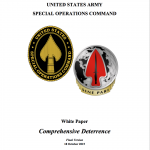Comprehensive Deterrence White Paper
Comprehensive Deterrence White Paper.
Author | Editor: U.S. Army Special Operations Command.
The emerging concept of Comprehensive Deterrence is an initial effort to broaden strategic options for our National leaders to meet current and emerging security challenges. Comprehensive Deterrence internalizes the challenge from then Secretary of Defense Hagel’s Defense Innovation Memorandum (15 November 2014) to pursue innovative ways to sustain and advance U.S military superiority for the 21st Century. Comprehensive Deterrence also acknowledges the guidance from General Martin Dempsey, Chairman of the Joint Chiefs of Staff, on 11 January 2015 when he noted that, “We’re going to have to think our way through the future, not bludgeon our way through it.”
Comprehensive Deterrence seeks to expand upon traditional concepts of deterrence to account for the totality and the variety of the threats we face in the early 21st Century security environment. It posits that deterrence, particularly on the left-side of the operational continuum, is not only about preventing something from happening, but also about preventing something from escalating beyond our strategic depth and our capability to respond, in a manner consistent with our National values.
Comprehensive Deterrence is defined as the prevention of adversary action through the existence or proactive use of credible physical, cognitive and moral capabilities that raise an adversary’s perceived cost to an unacceptable level of risk relative to the perceived benefit.
Key themes within the concept of Comprehensive Deterrence include: 1) Existing theories of deterrence generally focus on high-end conflict conducted by Nation States on the right-side of the operational continuum. Investment in deterrence thinking on the left-side of the operational continuum is warranted to meet the growing challenges the United States and its Allies face in the Gray Zone; 2) The totality of the security challenges and the varied nature of these challenges require reframing of what constitutes strategic power and strategic risk in a complex and unpredictable world; 3) The growing trans-regional aspects of competition and conflict require new planning models, new operational constructs, new ways of thinking, and fully integrated partner networks to rescale security challenges earlier in their trajectory; 4) Select state and non- state actors are effectively operating in the Gray Zone, which demands study of how we build the nuanced inter / intra governmental multi-year campaigns that are required to successfully compete and win in this space; and 5) Comprehensive Deterrence points to a grand strategy to deliver more effective security for the Nation.
The conceptual lines of effort within Comprehensive Deterrence are; 1) Expanding the Strategic Start Point, 2) Rethinking Strategic Power and Reframing Power Projection with two sub- components, Partner Based Power and Population Based Power, 3) Rethinking Asymmetric Approaches, 4) Rethinking the Strategic Nexus between the Land and Human Domains, 5) Broadening Considerations of Strategic Risk, and 6) Expanding Technology Solutions for the Human Domain.
The concept of Comprehensive Deterrence is an outgrowth of the United States Special Operations Command’s (USSOCOM) and the United States Army Special Operations Command’s (USASOC) futures and wargaming platforms. The adjective, comprehensive, speaks to deterrence across the operational continuum and to the application of a Whole of Government / Whole of Partner framework to enable its full realization.

Comments